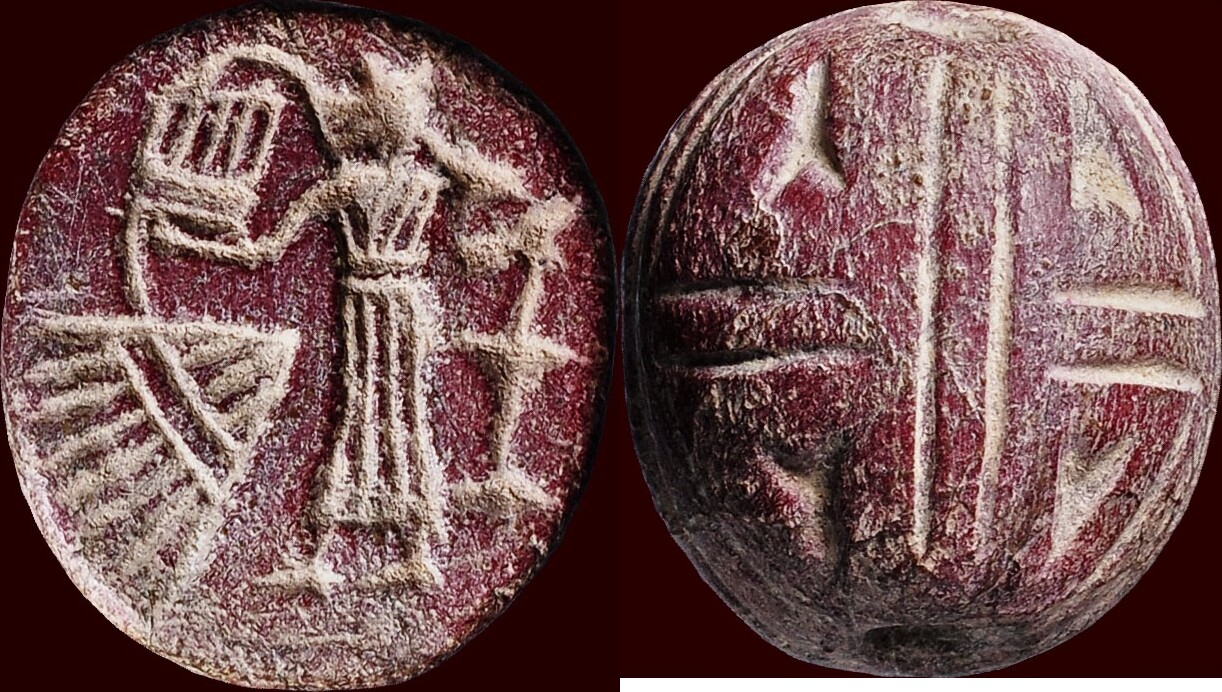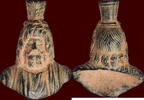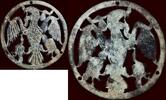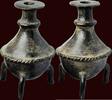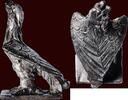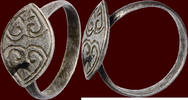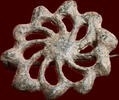MA-ID: 7324602010
Customer feedback Henzen
Schnelle Lieferung. Super Ware. Vielen Dank!
O.K.
perfekt !!!
Great coin, quick delivery, thanks!
800-700 BC v. Chr. ARCHAEOLOGICAL OBJECT - CILICIA / NORTHERN SYRIA - Scaraboid Seal, circa 800-700 BC
Munthandel G.Henzen 

10
On MA-Shops since 10 years
7244 ratings,
100 % Positive (last 24 months)
Worldwide shipping
823.60 £950,00 EUR
Import tax may be added
+ 22.54 £ shipping ( to United Kingdom )
Delivery time: 5 - 8 days
+ 22.54 £ shipping ( to United Kingdom )
| Customer Support +49 (0)2871 2180 383 |
| Payment methods |
| Wire Transfer |
Lyre-Player Group
circa 28x25mmx19mm. | weight 11,90 gram
reddish brown limestone
Pierced along the entire length, to be able to wear on a cord
stamp image: standing person (Kinnaru) with Lyre, behind a standing bird,
in front a v-shaped object with protruding antennae, which symbolizes
the sacred tree
This seal type belongs to the so-called Lyre-Player Group seals. These are related to the Divine Kinnaru, originally an Ugaritic god from the Mesopotamia / Near East region, who functioned as the deification of a string instrument, most likely the lyre. It is sometimes assumed that a mythical king of Cyprus mentioned in the Iliad, Kinyras, was derived from him. This god was widely worshiped in Mesopotamia, eastern Anatolia, Syria and the Levant, and is depicted on seals such as this one.
Such seals have been found in Cilicia, which can be dated to the 8th century BC and should be connected with the traditions allying Kynyras to Cilicia. Such a geographical association should be surprising neither for Kinyras himself, not the seals′ imagery, given the influence of several factors: the existence of Kinnaru of Ugarit and probably other regional Syrian cognates the Syro-Hurrian adstrate in Cilicia/Kizzuwatna the persistence of Hittite royal ideology in Neo-Hettite states and Phoenician influence in Cilicia. The Lyre-Player Group was first identified by Christian Blinkenberg in 1931, who described 14 specimens from Lindos (Rhodos) and another 31 images from various collections he rather acutely detected a blend of Cypriot and ′late Hittite′ elements, and made several observations still generally accepted the seals were the product of a single workshop operating over a limited period in the eighth century BC. Because initially most specimens were found on Rhodes, it was assumed that they were produced there. Later, however, more specimens were found in Cilicia, so that production is now suspected in the area Cilicia/Northern-Syria, what used to be the neo-Hittite principality of Que (or Hiyawa/Adanawa).
reference literature|
- Franklin John Curtis Theios Aoidos. A New Reading of the Lyre-Player
Group of Seals. In: Gaia : revue interdisciplinaire sur la Grèce Archaïque,
numéro 18, 2015. pp. 405-418
- Serrano, L., Gonzales de Canales, F., Llompart, J. and Montano, A.
Scaraboid seal of the “Lyre-Player Group” at the Huelva Museum
Provenance: German private collection. Acquired on the German
art market in the 1980′s / 1990′s
Highly interesting and rare seal stamp.
intact
reddish brown limestone
Pierced along the entire length, to be able to wear on a cord
stamp image: standing person (Kinnaru) with Lyre, behind a standing bird,
in front a v-shaped object with protruding antennae, which symbolizes
the sacred tree
This seal type belongs to the so-called Lyre-Player Group seals. These are related to the Divine Kinnaru, originally an Ugaritic god from the Mesopotamia / Near East region, who functioned as the deification of a string instrument, most likely the lyre. It is sometimes assumed that a mythical king of Cyprus mentioned in the Iliad, Kinyras, was derived from him. This god was widely worshiped in Mesopotamia, eastern Anatolia, Syria and the Levant, and is depicted on seals such as this one.
Such seals have been found in Cilicia, which can be dated to the 8th century BC and should be connected with the traditions allying Kynyras to Cilicia. Such a geographical association should be surprising neither for Kinyras himself, not the seals′ imagery, given the influence of several factors: the existence of Kinnaru of Ugarit and probably other regional Syrian cognates the Syro-Hurrian adstrate in Cilicia/Kizzuwatna the persistence of Hittite royal ideology in Neo-Hettite states and Phoenician influence in Cilicia. The Lyre-Player Group was first identified by Christian Blinkenberg in 1931, who described 14 specimens from Lindos (Rhodos) and another 31 images from various collections he rather acutely detected a blend of Cypriot and ′late Hittite′ elements, and made several observations still generally accepted the seals were the product of a single workshop operating over a limited period in the eighth century BC. Because initially most specimens were found on Rhodes, it was assumed that they were produced there. Later, however, more specimens were found in Cilicia, so that production is now suspected in the area Cilicia/Northern-Syria, what used to be the neo-Hittite principality of Que (or Hiyawa/Adanawa).
reference literature|
- Franklin John Curtis Theios Aoidos. A New Reading of the Lyre-Player
Group of Seals. In: Gaia : revue interdisciplinaire sur la Grèce Archaïque,
numéro 18, 2015. pp. 405-418
- Serrano, L., Gonzales de Canales, F., Llompart, J. and Montano, A.
Scaraboid seal of the “Lyre-Player Group” at the Huelva Museum
Provenance: German private collection. Acquired on the German
art market in the 1980′s / 1990′s
Highly interesting and rare seal stamp.
intact
Please respect our order minimum of 20 Euros. For EU only IBAN payment please. Shippings to China are on risk of the buyer and only payment by bankwire or WISE. Shipping will take place within 5 days after receipt of payment. Sendings to Russia,Ukraine and Israel are not possible. Additional administration- and risk costs for PayPal & creditcard payments. No PayPal or creditcardpayments possible for orders over 10.000 euro.
| Shipping fees | ||||
|---|---|---|---|---|
| up to 86.70 £ | 86.70 £ to 433.48 £ | 433.48 £ to 866.95 £ | over 866.95 £ | |
| Argentina | 27.74 £ | 27.74 £ | 34.68 £ | 34.68 £ |
| Australia | 30.34 £ | 30.34 £ | 34.68 £ | 34.68 £ |
| Belgium | 8.24 £ | 9.54 £ | 11.27 £ | 15.61 £ |
| Brazil | 47.68 £ | 47.68 £ | 47.68 £ | 47.68 £ |
| Bulgaria | 12.14 £ | 13.87 £ | 30.34 £ | 39.01 £ |
| Chile | 43.35 £ | 43.35 £ | 43.35 £ | 43.35 £ |
| China | 34.68 £ | 34.68 £ | 43.35 £ | 43.35 £ |
| Denmark | 9.97 £ | 11.27 £ | 13.87 £ | 17.34 £ |
| Germany | 8.24 £ | 9.54 £ | 11.27 £ | 15.61 £ |
| Estonia | 11.27 £ | 12.14 £ | 13.00 £ | 21.67 £ |
| France | 8.24 £ | 9.54 £ | 13.87 £ | 21.67 £ |
| Greece | 13.00 £ | 21.67 £ | 26.01 £ | 30.34 £ |
| United Kingdom | 21.67 £ | 21.67 £ | 22.54 £ | 24.27 £ |
| Hong Kong | 34.68 £ | 34.68 £ | 43.35 £ | 43.35 £ |
| India | 30.34 £ | 30.34 £ | 34.68 £ | 43.35 £ |
| Indonesia | 30.34 £ | 30.34 £ | 34.68 £ | 34.68 £ |
| Israel | 173.39 £ | 173.39 £ | 173.39 £ | 173.39 £ |
| Japan | 34.68 £ | 34.68 £ | 34.68 £ | 34.68 £ |
| Cambodia | 56.35 £ | 56.35 £ | 56.35 £ | 56.35 £ |
| Canada | 26.01 £ | 26.01 £ | 30.34 £ | 30.34 £ |
| Liechtenstein | 17.34 £ | 17.34 £ | 21.67 £ | 21.67 £ |
| Luxembourg | 9.54 £ | 11.27 £ | 13.87 £ | 21.67 £ |
| Malaysia | 30.34 £ | 30.34 £ | 34.68 £ | 39.01 £ |
| Netherlands | 7.37 £ | 7.37 £ | 9.54 £ | 12.14 £ |
| Norway | 21.67 £ | 21.67 £ | 26.01 £ | 30.34 £ |
| Austria | 9.97 £ | 10.84 £ | 13.00 £ | 21.67 £ |
| Poland | 11.27 £ | 12.14 £ | 14.30 £ | 21.67 £ |
| Portugal | 11.27 £ | 12.14 £ | 15.61 £ | 21.67 £ |
| Romania | 13.87 £ | 15.61 £ | 21.67 £ | 30.34 £ |
| Russian Federation | 173.39 £ | 173.39 £ | 173.39 £ | 173.39 £ |
| Switzerland | 26.01 £ | 26.01 £ | 34.68 £ | 34.68 £ |
| Serbia | 21.67 £ | 21.67 £ | 26.01 £ | 30.34 £ |
| Singapore | 30.34 £ | 30.34 £ | 30.34 £ | 34.68 £ |
| Slovakia | 11.27 £ | 13.00 £ | 17.34 £ | 21.67 £ |
| Spain | 9.97 £ | 11.70 £ | 14.30 £ | 21.67 £ |
| Sri Lanka | 30.34 £ | 30.34 £ | 34.68 £ | 39.01 £ |
| Czech Republic | 10.40 £ | 12.14 £ | 15.61 £ | 21.67 £ |
| Ukraine | 173.39 £ | 173.39 £ | 173.39 £ | 173.39 £ |
| Hungary | 12.14 £ | 13.87 £ | 21.67 £ | 26.01 £ |
| United States | 27.74 £ | 27.74 £ | 30.34 £ | 34.68 £ |
| European Union | 13.00 £ | 14.74 £ | 21.67 £ | 26.01 £ |
| World | 34.68 £ | 34.68 £ | 43.35 £ | 43.35 £ |
Information
Online orders are welcome as always and will be shipped directly.
|
Seller Home | 0Shopping cart | Terms of sale | Contact | MA Terms of sale | Privacy policy | Warranty | MA-Shops New Items Copyright ® 2001-2025, MA-SHOPS Coins All Rights Reserved. Designated trademarks and brands are the property of their respective owners. |
 Buy coins with warranty
Buy coins with warranty



